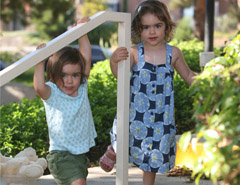
Twin toddlers Amelia (left) and Sophia are on the road to normal lives after surgeries to correct severe heart defects.
Two-year-old Amelia likes to wear mismatched shoes, like one black classic Mary Jane and one psychedelic pink and green sneaker. Her identical twin sister, Sophia, has a mor
e conservative style and prefers dresses to shorts. While their tastes may differ, the sisters share a common bond. Both were born with severe heart defects.
When their mother, Leslie, was pregnant, she was surprised to learn that she was going to have twins. Like most first-time parents, she and her husband, Kris, didn’t quite know what to expect. Then, 20 weeks into the pregnancy, an ultrasound revealed that both babies had congenital heart disease. They were totally unprepared for what lay ahead.
Initially doctors thought that both girls had Tetralogy of Fallot (fuh-LOE), a combination of four different abnormalities, including a “hole” in the heart and the narrowing of the valve leading to the pulmonary arteries. The condition occurs in about 5 out of every 10,000 babies. Despite its seeming complexity, it can often be completely repaired.
When the twins were born at UCSD Medical Center in Hillcrest on April 13, 2006, Sophia did indeed have Tetralogy of Fallot. Amelia, however, was diagnosed with Truncus Arteriosus, a less common and more serious condition in which one single vessel or “trunk” (truncus) with only one valve leads out of the heart. If left untreated, this defect can lead to irreversible and life-threatening complications.
Sophia (who is called Sophie) remained in the Neonatal Intensive Care Unit (NICU) at UCSD for 12 days before her parents could take her home. Amelia had already been transferred to Rady Children’s NICU in preparation for surgery.
“Those first six weeks – becoming first-time parents of twins, not being able to bring our babies home with us, having one newborn daughter go through open-heart surgery while taking care of her sister at home, going back and forth to Rady Children’s – we were definitely on an emotional rollercoaster,” says Leslie, a preschool teacher. “We really discovered our strength as a couple. When I was up, he was down, and vice versa, we took turns being optimistic and scared.”
The couple had every reason to be both optimistic and scared. On the one hand, they were reassured to know that, with early diagnosis and appropriate treatment, most children with congenital heart defects can live relatively normal lives. On the other hand, both girls would require open-heart surgery – a really scary proposition for any parent.
Amelia was only 5 days old when she had her first open-heart surgery. Dr. Jolene Kriett, a cardiothoracic surgeon at Rady Children’s and Professor of Surgery at UCSD, patched the hole between Amelia’s ventricles and placed a tube – called a conduit – in the heart to restore normal blood flow from the heart to the lungs. Usually this conduit must be replaced as the child grows.
In Amelia’s case, the tube (a homograft) she received at 5 days old was replaced with a bovine jugular vein at 13 months. This was her second open-heart surgery, but will not be her last.
“Amelia will undoubtedly need multiple heart surgeries,” says Dr. Paul Grossfeld, Pediatric Cardiology specialist at Rady Children’s Heart Institute and the girls’ cardiologist. Leslie sees a certain irony in the fact that her young, mostly vegetarian daughter is being kept alive by a vein from a cow!
In between Amelia’s two surgeries, Kriett performed open-heart surgery on 5-month-old Sophie. Sophie’s surgery was less complex and she went home after six days, but “It took several months for Sophie to recover emotionally,” recounts Leslie.
Now at age 2, the twins have a new lease on life. Sophie is checked every six months and needs no medication. Amelia is monitored more closely. She comes to Rady Children’s every three months for a sedated echocardiogram and doctor’s appointment. She takes medication to control her blood pressure.
“By the time Sophie and Amelia have children of their own,” says Grossfeld, “we should know much more about the genetic causes of heart defects.” He hopes that, by then, researchers will have identified the specific gene that causes their congenital heart disease, enabling them to prevent a recurrence. In the meantime, the twins’ parents face up to a 50 percent chance of having another child with a similar congenital heart defect.
Both girls are bright and articulate; they love to make up stories, help their dad “fix” their bikes and cook with their mom. They just started preschool where their mother is a teacher. The girls are naturally close and take turns at being goofy.
Sophie is still larger and more robust than her sister, but both have energy to spare. As the two toddlers careen around the grassy area behind their Vista home, you would never know that they had had open-heart surgery. Only the scars that run the length of their small chests hint at their medical history.
“When Sophie and Amelia come into my office for check-ups,” says Grossfeld, “I’m always gratified to see them so active.” For twins born with heart defects, that’s nothing short of miraculous.
Originally published in Kids’ NewsDay, San Diego Union-Tribune,
October 7, 2008.